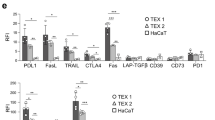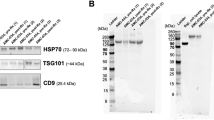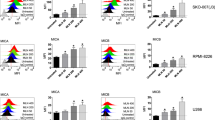Abstract
MICA is a ligand of the activating receptor NKG2D, expressed by NK and T cells. MICA expression is induced in cancer cells favoring their elimination by the immune system; however, many advanced tumors shed soluble MICA (sMICA), which impairs NKG2D-mediated cytotoxicity. ERp5 and GRP78 are endoplasmic reticulum-resident proteins that are translocated to the surface of epithelial tumor cells where they interact with MICA and are involved in sMICA shedding. In this study, we analyze the role of ERp5 and GRP78 in sMICA shedding in chronic lymphocytic leukemia (CLL). Immunofluorescence and flow cytometry analyses showed that ERp5 and GRP78 were significantly expressed on the surface of B cells and leukemia cells, but they were not expressed on T cells. The expression of ERp5 and GRP78 was significantly higher in leukemia cells than in B cells from controls. ERp5 and GRP78 co-localized with MICA on the surface of leukemia cells and the levels of expression of ERp5 and GRP78 correlated with the level of expression of membrane-bound MICA in CLL patients. Associated with higher expression of membrane-bound ERp5 and GRP78, serum sMICA levels were approximately threefold higher in patients than in controls. Elevated sMICA levels in CLL patients were associated with the down-modulation of NKG2D surface expression on CD8 T cells. Finally, pharmacological inhibition of B cell lines and stimulated leukemia cells showed that ERp5 activity is involved in sMICA shedding in CLL. In conclusion, these results uncover a molecular mechanism which regulates MICA protein shedding and immune evasion in CLL.






Similar content being viewed by others
References
Bauer S, Groh V, Wu J, Steinle A, Phillips JH, Lanier LL, Spies T (1999) Activation of NK cells and T cells by NKG2D, a receptor for stress-inducible MICA. Science 285:727–729. doi:10.1126/science.285.5428.727
Raulet DH (2003) Roles of the NKG2D immunoreceptor and its ligands. Nat Rev Immunol 3:781–790. doi:10.1038/nri1199
Lopez-Larrea C, Suarez-Alvarez B, Lopez-Soto A, Lopez-Vazquez A, Gonzalez S (2008) The NKG2D receptor: sensing stressed cells. Trends Mol Med 14:179–189. doi:10.1016/j.molmed.2008.02.004
Bahram S, Bresnahan M, Geraghty DE, Spies T (1994) A second lineage of mammalian major histocompatibility complex class I genes. Proc Natl Acad Sci USA 91:6259–6263. doi:10.1073/pnas.91.14.6259
Groh V, Rhinehart R, Secrist H, Bauer S, Grabstein KH, Spies T (1999) Broad tumour-associated expression and recognition by tumour-derived gamma delta Tcells of MICA and MICB. Proc Natl Acad Sci USA 96:6879–6884. doi:10.1073/pnas.96.12.6879
Gasser S, Orsulic S, Brown EJ, Raulet DH (2005) The DNA damage pathway regulates innate immune system ligands of the NKG2D receptor. Nature 436:1186–1190. doi:10.1038/nature03884
Groh V, Bahram S, Bauer S, Herman A, Beauchamp M, Spies T (1996) Cell stress-regulated human major histocompatibility complex class I gene expressed in gastrointestinal epithelium. Proc Natl Acad Sci USA 93:12445–12450. doi:10.1073/pnas.93.22.12445
González S, López-Soto A, Suárez-Álvarez B, López-Vázquez A, López-Larrea C (2008) NKG2D ligands: key targets of the immune response. Trends Immunol 14:179–189. doi:10.1016/j.it.2008.04.007
Diefenbach A, Jensen ER, Jamieson AM, Raulet DH (2001) Rae1 and H60 ligands of the NKG2D receptor stimulate tumor immunity. Nature 413:165–171. doi:10.1038/35093109
Cerwenka A, Baron JL, Lanier LL (2001) Ectopic expression of retinoic acid early inducible-1 gene (RAE-1) permits natural killer cell-mediated rejection of a MHC class I-bearing tumor in vivo. Proc Natl Acad Sci USA 98:11521–11526. doi:10.1073/pnas.201238598
Lopez-Soto A, Folgueras AR, Seto E, Gonzalez S (2009) HDAC3 represses the expression of NKG2D ligands ULBPs in epithelial tumor cells: potential implications for the immunosurveillance of cancer. Oncogene 28:2370–2382. doi:10.1038/onc.2009.117
Groh V, Wu J, Yee C, Spies T (2002) Tumour-derived soluble MIC ligands impair expression of NKG2D and T-cell activation. Nature 419:734–738. doi:10.1038/nature01112
Salih HR, Rammensee HG, Steinle A (2002) Cutting edge: down-regulation of MICA on human tumors by proteolytic shedding. J Immunol 169:4098–4102
Salih HR, Antropius H, Gieseke F, Lutz SZ, Kanz L, Rammensee HG, Steinle A (2003) Functional expression and release of ligands for the activating immunoreceptor NKG2D in leukemia. Blood 102:1389–1396. doi:10.1182/blood-2003-01-0019
Rebmann V, Schütt P, Brandhorst D, Opalka B, Moritz T, Nowrousian MR, Grosse-Wilde H (2007) Soluble MICA as an independent prognostic factor for the overall survival and progression-free survival of multiple myeloma patients. Clin Immunol 123:114–120. doi:10.1016/j.clim.2006.11.007
Nückel H, Switala M, Sellmann L, Horn PA, Dürig J, Dührsen U, Küppers R, Grosse-Wilde H, Rebmann V (2010) The prognostic significance of soluble NKG2D ligands in B-cell chronic lymphocytic leukemia. Leukemia. doi:10.1038/leu.2010.74
Jordan PA, Stevens JM, Hubbard GP, Barrett NE, Sage T, Authi KS, Gibbins JM (2005) A role for the thiol isomerase protein ERP5 in platelet function. Blood 105(4):1500–1507. doi:10.1182/blood-2004-02-0608
Tager M, Kroning H, Thiel U, Ansorge S (1997) Membrane-bound protein disulphide isomerase (PDI) is involved in regulation of surface expression of thiols and drug sensitivity of B-CLL cells. Exp Hematol 25:601–607
Holbrook LM, Watkins NA, Simmonds AD, Jones CI, Ouwehand WH, Gibbins JM (2010) Platelets release novel thiol isomerase enzymes which are recruited to the cell surface following activation. Br J Haematol 148(4):627–637. doi:10.1111/j.1365-2141.2009.07994
Kaiser BK, Yim D, Chow IT, González S, Dai Z, Mann HH, Strong RK, Groh V, Spies T (2007) Disulphide-isomerase-enabled shedding of tumour-associated NKG2D ligands. Nature 447:482–486. doi:10.1038/nature05768
Zhang LH, Zhang X (2010) Roles of GRP78 in physiology and cancer. J Cell Biochem 110(6):1299–1305. doi:10.1002/jcb.22679
Jinushi M, Vanneman M, Munshi NC, Tai YT, Prabhala RH, Ritz J, Neuberg D, Anderson KC, Carrasco DR, Dranoff G (2008) MHC class I chain-related protein A antibodies and shedding are associated with the progression of multiple myeloma. Proc Natl Acad Sci USA 105:1285–1290. doi:10.1073/pnas.0711293105
Fonseca C, Soiffer R, Ho V, Vanneman M, Jinushi M, Ritz J, Neuberg D, Stone R, DeAngelo D, Dranoff G (2009) Protein disulfide isomerases are antibody targets during immune-mediated tumor destruction. Blood 113:1681–1688. doi:10.1182/blood-2007-09-114157
Hallek M, Cheson BD, Catovsky D, Caligaris-Cappio F, Dighiero G, Döhner H, Hillmen P, Keating MJ, Montserrat E, Rai KR, Kipps TJ (2008) Guidelines for the diagnosis and treatment of chronic lymphocytic leukemia: a report from the international workshop on chronic lymphocytic leukemia updating the National Cancer Institute-working group 1996 guidelines. Blood 111:5446–5456. doi:10.1182/blood-2007-06-093906
Hamblin TJ, Orchard JA, Ibbotson RE, Davis Z, Thomas PW, Stevenson FK, Oscier DC (2002) CD38 expression and immunoglobulin variable region mutations are independent prognostic variables in chronic lymphocytic leukemia, but CD38 expression may vary during the course of the disease. Blood 99(3):1023–1029. doi:10.1182/blood.V99.3.1023
Nückel H, Rebmann V, Dürig J, Dührsen U, Grosse-Wilde H (2005) HLA-G expression is associated with an unfavorable outcome and immunodeficiency in chronic lymphocytic leukemia. Blood 105(4):1694–1698. doi:10.1182/blood-2004-08-3335
Wiemann K, Mittrücker HW, Feger U, Welte SA, Yokoyama WM, Spies T, Rammensee HG, Steinle A (2005) Systemic NKG2D down-regulation impairs NK and CD8 T cell responses in vivo. J Immunol 175(2):720–729
Kohga K, Takehara T, Tatsumi T, Miyagi T, Ishida H, Ohkawa K, Kanto T, Hiramatsu N, Hayashi N (2009) Anticancer chemotherapy inhibits MHC class I-related chain a ectodomain shedding by downregulating ADAM10 expression in hepatocellular carcinoma. Cancer Res 69(20):8050–8057. doi:10.1158/0008-5472.CAN-09-0789
Kohga K, Takehara T, Tatsumi T, Ishida H, Miyagi T, Hosui A, Hayashi N (2010) Sorafenib inhibits the shedding of major histocompatibility complex class I-related chain A on hepatocellular carcinoma cells by down-regulating a disintegrin and metalloproteinase 9. Hepatology 51(4):1264–1273. doi:10.1002/hep.23456
Liu G, Atteridge CL, Wang X, Lundgren AD, Wu JD (2010) The membrane type matrix metalloproteinase MMP14 mediates constitutive shedding of MHC class I chain-related molecule A independent of A disintegrin and metalloproteinases. J Immunol 184(7):3346–3350. doi:10.4049/jimmunol.0903789
Acknowledgments
This work was supported by the Spanish grants of Fondo de Investigaciones Sanitarias (Institute Carlos III) PS09/00420 and FIS PI08/0566. ALS holds a predoctoral fellowship from FICYT of Asturias (BP06-99).
Conflict of interest
The authors declare that they have no conflict of interest.
Author information
Authors and Affiliations
Corresponding author
Rights and permissions
About this article
Cite this article
Huergo-Zapico, L., Gonzalez-Rodriguez, A.P., Contesti, J. et al. Expression of ERp5 and GRP78 on the membrane of chronic lymphocytic leukemia cells: association with soluble MICA shedding. Cancer Immunol Immunother 61, 1201–1210 (2012). https://doi.org/10.1007/s00262-011-1195-z
Received:
Accepted:
Published:
Issue Date:
DOI: https://doi.org/10.1007/s00262-011-1195-z




